All photographs made on 1 and 2 November 2013 in San Felipe del Agua, Oaxaca, Mexico. See project statement.
On November 1 and 2 the souls of the departed visit their loved ones for a few hours. When they arrive they find an altar of flowers, candles and food, in accordance with family resources, set up in their honor: fruit and nuts in season, favorite desserts, a bottle of their preferred drink, candy for the angelitos (or innocents, deceased infants and children) and a few platters of Mexico’s best cuisine.
Mexicans are known for their close relationship with death, for having this celebration around it. Being in Oaxaca, one of the states where Day of the Dead, or Día de los Muertos, is most celebrated, I got a glimpse of the personal expression of this. The very existence of this holiday makes for a higher comfort level with the concept: to be thinking and talking about muertos makes death present in life.
Familia Zárate
Upon moving to San Felipe, I visit the local priest to ask for recommendations of families who might allow me into their homes, to record faith in private life. A young woman, Flor de María, is meeting with him and offers on the spot to take me to her parents; they in turn invite me to witness their altar-building on Day of the Dead. When Flor talks about the holiday, she is simultaneously a passionate believer and very modern. She says, of course the dead people don’t really come back, but the celebration allows the living to feel better about them being dead and perhaps reach peace with them.
On November 1, I meet Flor, her husband Raymundo and their toddler daughter outside her parents’ gate. They are making the rounds of friends and relatives’ homes today to deliver baskets with chocolate, fruit and homemade pan de muerto (bread with a ghostly face on top) for their altar. We wait outside a big blue metal gate with a questionable doorbell and lots and lots of chihuahuas behind it. Inside, Flor finds her mother and sister filling white 10-gallon buckets with flowers for the altar, after chopping off their roots with a machete. She bids her sister, who lives here with their parents, take me to cut more flor de muerto (marigolds, also known as cempasúchil), a wild version of which fills the fields all around us these days.
When we return, Raymundo is inside arranging a cross of marigold petals in front of the altar. The copal smoke is thick, the table heaped with food and drink for the deceased. It never looks all that appetizing a few hours or days in—greasy, cold hot chocolate, mole, tamales and the local delicacy of grasshoppers fried with salt and chile. But the abundance of it and the spirit—that good food for visiting souls is not food wasted, a gesture often made by those with so little themselves—make it look good.
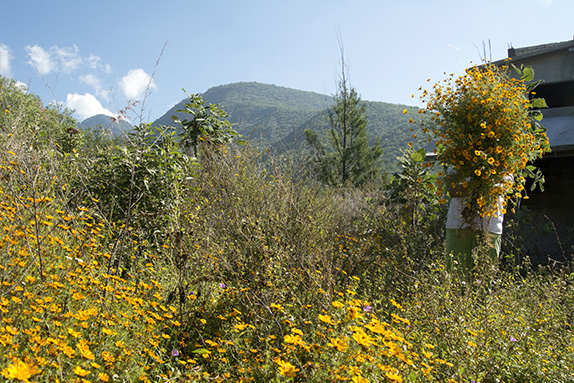
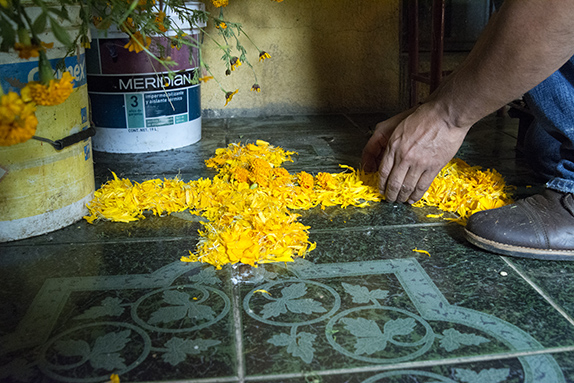

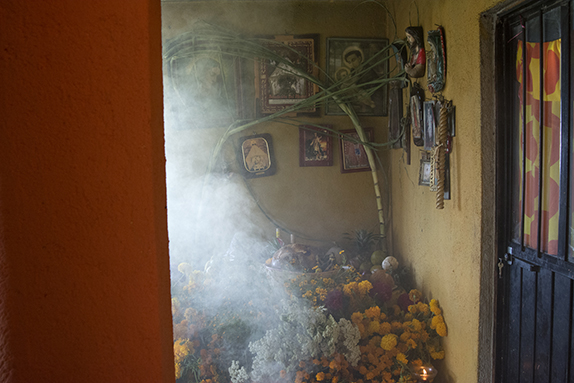
Familia Cruz Cruz
Tío Rogelio lives in the family home with a few of his adult siblings and their children. He is a designer by trade, creating bouquets and party decorations, and known for his elaborate altar and nativity at Christmas, which he constructs in honor of his mother who did the same. When I arrive he is out, arranging an altar for someone else, and has directed his sister Micaela and his niece to dismantle most of theirs: today it was for the angelitos; this afternoon he will reconstruct it for the fieles difuntos (deceased adults) who arrive tomorrow. Micaela shows me the basket of miniature clay pots they have just removed—the ones their little sister played with before she died.
Day of the Dead is approached with a combination of seriousness and levity that does justice to Mexicans’ famed duality. On one hand specifics are only ever mentioned in passing, if at all. But the tales I do hear are sad and sometimes tragic. In constructing and living with the altars there is much thought given to these stories; the point after all is to be accompanied for a short while by the souls who lived them.
When Tío Rogelio finally comes home, he goes right to work with the help of his nephew, Miguel Ángel, stripping down even more of the altar and reconfiguring it, adding an arch of flowers. When I leave, another two and a half hours of work lie ahead.

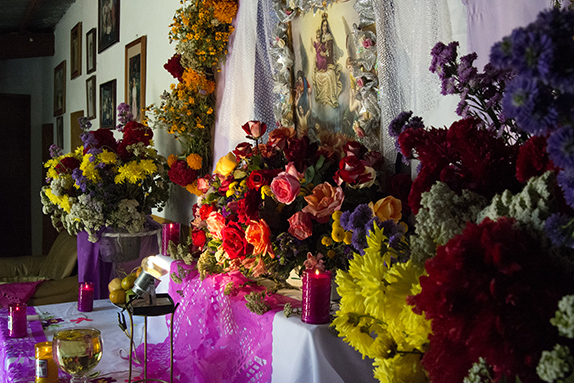
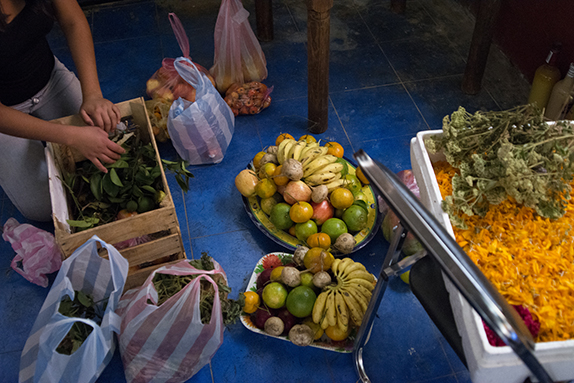
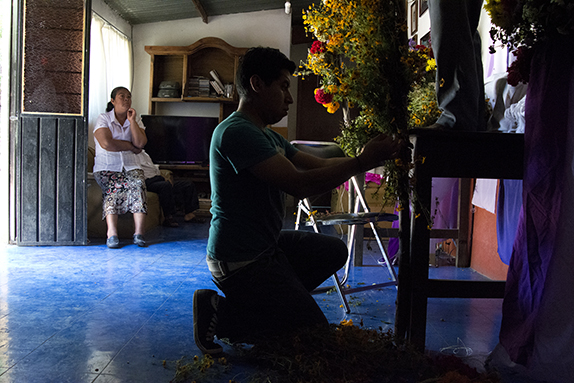
Camposanto
The cemeteries are famously alive in the evenings and late into the night, entire families picnicking at the gravesite with music and merriment. During the day I witness the clearing, painting and decorating of graves: each person with a different execution of an absolute abundance of flowers, creating borders, making designs of loose petals or colored, sparkling sand; candles set among them to be lit later on. Over the course of the day, the cemetery blooms. From gray it becomes a madness of orange; huge bundles of flor de muerto and cresta de gallo (cockscomb) hauled in on the backs of family members. We are steeped in marigolds and surrounded by skeletons.
A lot of the holiday is just for fun, at least on the surface: the kids at school, as well as plenty of people in the streets, dress up as skeletons to sing and dance. Gathering the elements of one’s altar and setting it up, as well as the caretaking of the gravesites, are creative acts. It’s art and when you do art, when you create, you feel happy, alive and interested in life. Each family partakes in this creativity; few farm it out to others. Because the holiday isn’t about gore or tragedy, there is a calmness surrounding the presence of los muertos, and a spirituality, often unspoken but usually present in Mexican life.
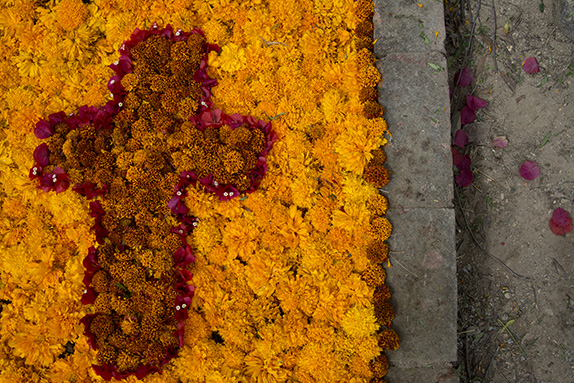
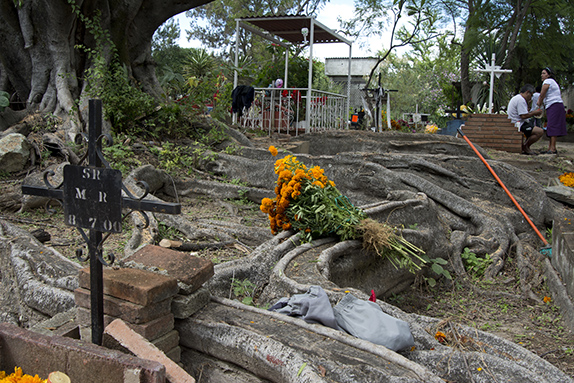
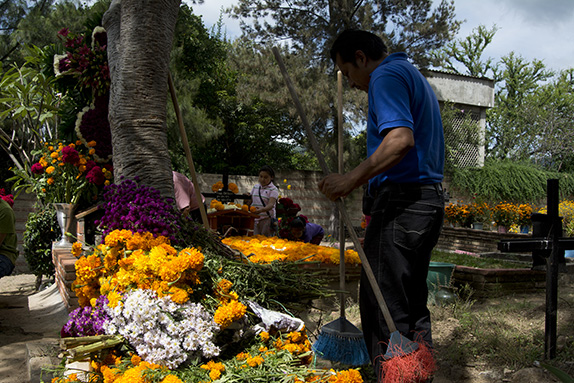
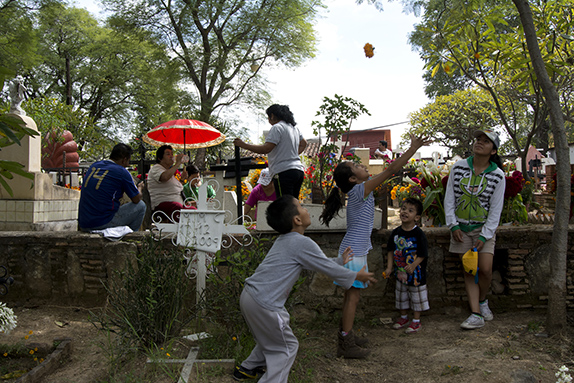

Project Statement: The del agua in “San Felipe del Agua” refers to the fact that a portion of the water from which the colonial Mexican city of Oaxaca lives, flows down from the gem green hills behind what was once a town but now exists as the edge of the larger city: lambs, donkeys, tropical flowers, and a half-hour bus ride to the center of a cosmopolitan metropolis. Those born in San Felipe have a separate set of rights and responsibilities to the community than those who move here. Those who move here tend to bring wealth, and often live behind high walls and drive dark-tinted SUVs.
My family and I lived in Mexico for one year and chose San Felipe because we found a wonderful school there for our children. Having grown up in New Mexico I have always been attracted to Catholic imagery and Guadalupe, growing up atheist I have always been fascinated by faith. And so, in Mexico, I photographed our neighborhood parish.
The photo essays resulting from this study will be published in the New Mexico Mercury from October 2014 through June 2015, roughly once a month on the date corresponding to the event photographed one year previous.


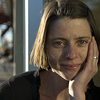

Responses to “Día de los muertos”